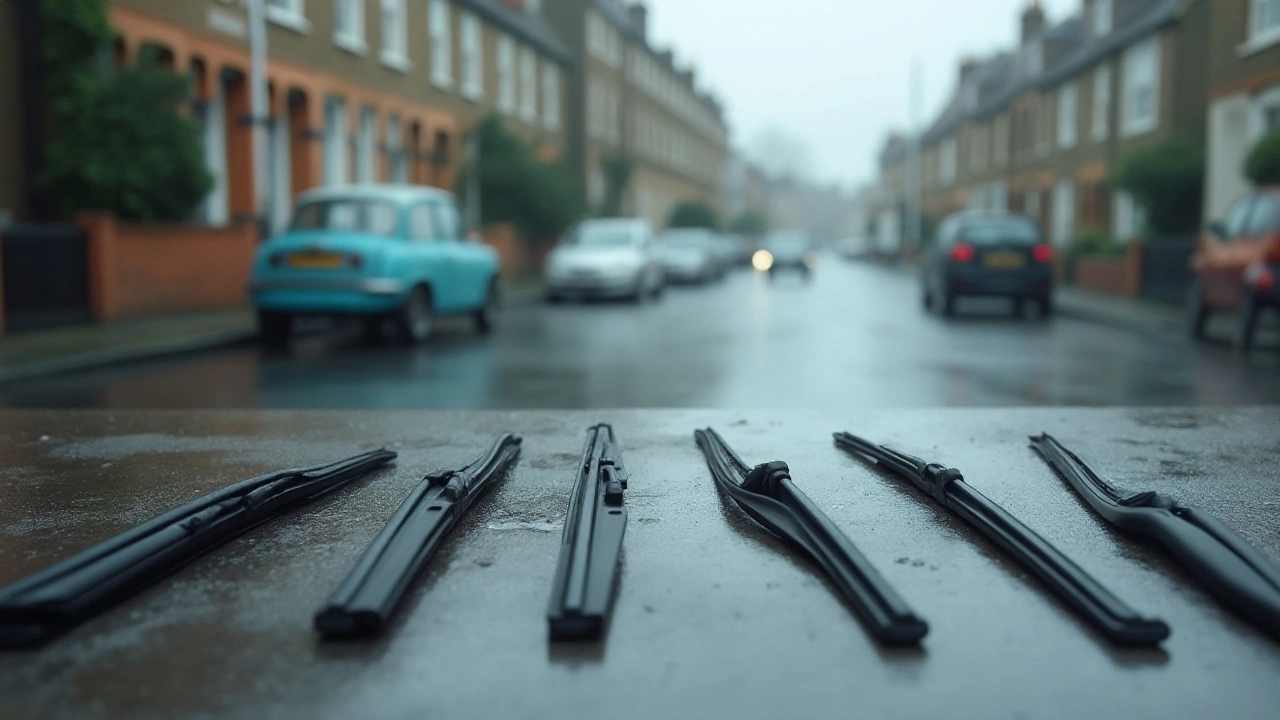Windscreen wipers might seem like a trivial part of your vehicle, but they play a vital role in ensuring your safety on the road. Choosing the right size for your car is not just about fitting them; it's about maintaining clear visibility during those unpredictable rainstorms. Have you ever been caught in the rain, squinting through the blur, and wished you had paid more attention to these nifty devices?
Maybe it's time to give those wipers the consideration they deserve. Understanding your windscreen wiper size is the first step towards a safer, more comfortable driving experience. Join us as we delve into everything you need to know to keep your view of the road clear and unobstructed. Whether you're a seasoned driver or a newbie behind the wheel, this guide has something for everyone.
- Why Wiper Size Matters
- How to Measure Your Wipers
- Types of Windscreen Wipers
- Tips for Proper Wiper Maintenance
- Signs It's Time to Replace Your Wipers
Why Wiper Size Matters
When it comes to windscreen wipers, the fit is crucial for more than just aesthetics. The size of your wipers directly affects their functionality and efficiency. Ill-fitting wipers can lead to streaks or even leaving large, unwiped areas on your car's windscreen, which jeopardizes visibility. The right-sized wipers ensure complete coverage of your windshield, clearing away rain, snow, or debris effectively. This is essential not only for the driver's vision but for safety, as a clear view can prevent accidents in adverse weather conditions. A report published by the National Highway Traffic Safety Administration revealed that poor visibility due to faulty wipers contributes to a significant percentage of weather-related accidents. Thus, taking a moment to ensure your wiper blade size is correct can enhance road safety considerably.
Selecting the appropriate wiper size isn't just about eliminating those obnoxious streaks or squeaks, it's about ensuring that each swipe is efficient. Properly sized wipers work in harmony with your windshield to distribute pressure evenly. This prevents unnecessary wear on certain parts of the windshield and prolongs the life of the wipers themselves. If you ever found yourself fussing with wipers that chatter endlessly across your glass, there's a chance it was due to a poor fit. Moreover, the chance of the wipers detaching during a drive increases if they aren't securely fixed, potentially leading to costly or dangerous situations. Let's not forget the increase in strain on the wiper motor due to incorrect sizing. Using the right wiper size can save on subsequent repair costs. If you're in doubt about the importance of wiper size, just remember that even though they might seem small and unassuming, they hold a mighty role in driving safety. Once you understand why size matters, the next step becomes identifying which size works best for your specific vehicle.
"Visibility is one of the most critical elements in driving safety, and proper wiper maintenance is fundamental to achieving it," - Auto Safety Expert, Simon Warrington.
How to Measure Your Wipers
At first glance, measuring your windscreen wipers might seem like a daunting task, especially if you're not the type to dive under the hood or tinker with car parts. But fear not, for it's a straightforward process that requires just a few minutes of your time and can make a world of difference in your driving visibility and safety. Knowing the correct size is key; wipers that are too small won't clear your window effectively, and those too large might collide or simply not fit.
The best place to start is your car's owner's manual, usually a wealth of knowledge on the specifications for parts like these. Finding your wiper size in there is as easy as flipping a few pages. But, if that manual seems to have disappeared into the void of used car purchases, online resources can help. Websites like Amazon or auto parts retailers often let you input your car’s make, model, and year to find suitable wiper sizes. Interestingly, there can sometimes be a difference in sizes between the driver and passenger sides, so make sure to verify both.
Want to go the extra mile and measure manually? It’s simple! Grab a tape measure, and follow this guide. First, lift your wiper arm away from the windshield gently; this avoids scratches or damage to both the wiper and glass. Next, measure the blade from one end to the other. Remember, measure the rubber blade itself, not the entire arm mechanism. Blade sizes typically come in ranges from about 10 to 28 inches. Being accurate is crucial, as a mere inch can greatly affect performance.
Steps for Manual Measurement
- Lift the wiper arm gently to avoid any damage.
- Lay the wiper straight and flat.
- Use a tape measure to measure from one end of the blade to the other.
- Record the measurement accurately in inches.
Here's a useful tip: if you're planning a replacement, consider changing blades before they wear out completely. This ensures you're not caught off guard during a heavy rainfall or snowstorm. The American Automobile Association (AAA) suggests replacing your wipers every six months to a year. Some even set reminders for such seasonal maintenance. “Properly functioning wiper blades are as critical as functional brakes,” says AAA, avoiding the temptation of pushing them beyond their limit.
Take a look at this basic table of common wiper sizes for various vehicle types to give you a rough idea of what to expect. Yet, remember, always verify with your own specific model's requirements to ensure accuracy:
| Vehicle Type | Typical Wiper Size (Driver's Side) | Typical Wiper Size (Passenger's Side) |
|---|---|---|
| Sedan | 20-24 inches | 18-20 inches |
| SUV | 22-28 inches | 20-24 inches |
| Truck | 24-28 inches | 22-26 inches |
Arming yourself with this knowledge, measuring your wiper blades moves from an intimidating chore to a simple routine check-up, as essential as topping off the windshield wiper fluid. It ensures your drives are safer, more comfortable, and a bit more stress-free, regardless of the weather you find yourself navigating through. So, next time the raindrops obscure your view, rest easy knowing you’ve fitted your car with the perfect size of wipers, keeping your path clear and your mind at ease.

Types of Windscreen Wipers
The world of windscreen wipers is more diverse than one might initially think. Not all wipers fit all vehicles, and understanding the types available can save you time and headache when it's time for replacement. Traditional frame style wipers have been around the longest. They consist of a metal frame with a rubber blade, a design that has been reliable and widespread for decades. These wipers are affordable and effective in moderate weather conditions. However, they struggle in more extreme environments, often clogged by snow and ice or leaving streaks during heavy rainfall.
At the other end of the spectrum, we have beam-style wiper blades. A modern upgrade, they boast a single rubber body without the framework, allowing even pressure across the windshield. This design immensely improves performance, especially during those unexpected downpours, providing clear vision with each swipe. Though they come at a higher cost, many drivers vouch for their reliability, especially in harsher climates. For those really looking to keep their car in tip-top shape, hybrid models offer a compromise between the old and new. Featuring a frame-style structure with a modern rubber overlay, hybrid wipers cater to drivers who wish to blend tradition and modernity.
Then, there is the specialty category for those with specific needs, such as rear wiper blades, often found on hatchbacks and SUVs. Don’t overlook these! Ensuring the rear view is clear is just as crucial, especially when reversing during wet or foggy conditions. Did you know the longest lasting wiper blades are designed to endure over 1 million swipes? It's fascinating how science and engineering collaborate even in auto accessories! As the winter months approach or autumn leaves obscure the roads, many drivers ponder these small yet significant components of vehicle safety. Interestingly, a study by the Automotive Researchers of America found that 20% of accidents in heavy rain are linked to poor visibility due to old wiper blades.
"Investing in quality windscreen wipers might seem trivial, but it transforms the driving experience in challenging weather," states John Turner, Chief Engineer at Auto Innovations.Whether swaying towards classic styles or experimenting with modern innovations, selecting the right windscreen wiper can make a world of difference in your daily commute. So, the next time you hear that tell-tale streaking noise or spot a glaring smudge that won’t go away, remember to consider the type of wiper that matches both your vehicle and the climate you frequently drive in.
Tips for Proper Wiper Maintenance
Your windscreen wipers are unsung heroes, working silently in the background to keep your view crystal clear. To keep them in top shape, regular maintenance is key. Let's delve into some essential tips that can extend the lifespan of these vital components and ensure they perform at their best when you need them most. Proper care not only prevents sudden failures but also improves your driving experience, especially during inclement weather.
First, let's talk about cleaning. Dirt and debris can build up on the wiper blades, reducing their efficiency. It's advisable to clean your windscreen wipers at least once a week. Gently lift the blades from the windshield, then use a mixture of water and mild detergent to wipe them down with a soft cloth. Avoid using harsh chemicals or solvents, as these can degrade the rubber. Cleaning not only prevents streaking but also helps you avoid those rattling noises that can drive you up the wall during a long journey.
Inspection is another crucial step. Regularly check the physical condition of the blades. Look for signs of wear and tear like cracks, fraying, or even excessive stiffness in the rubber. These are indicators that the blades might not be up to the task during severe weather conditions. Catching these signs early can save you the hassle of sudden blade failure when you're least prepared. If anything looks amiss, it might be time for a replacement. Manufacturers generally recommend replacing your wipers every six months, but this can vary depending on the climate and usage.
Periodically check the wiper arm alignment as well. Misalignment can cause uneven pressure on the blades, leading to inadequate wiping and streaks. If you notice your blades are not sitting flush on the windshield, or they leave gaps while operating, adjusting the arms can solve this problem. This small tweak can make a world of difference when you're caught in a torrential downpour, desperately trying to peer through a foggy windshield. Sometimes, all it takes is a quick manual adjustment to restore everything to working order.
Don't underestimate the role of the windshield itself. Keeping it clean and free of grime also contributes to the effectiveness of your car maintenance. Even the best wipers can't do much if they're fighting against layers of dirt and sticky residue on the glass. Apply a glass cleaner regularly to ensure a spotless surface. This not only prolongs the life of your wipers but also aids in the swift removal of rainwater, improving visibility exponentially.
Temperature changes pose another challenge to the durability of your wipers. Extreme heat can cause the rubber to warp, making it less effective over time. During harsh winter months, ensure that the blades haven't frozen to the windshield. Pull them up during snowstorms to prevent this from happening, and avoid using them to scrape off ice, as this can severely damage the blade edge. A proactive approach helps to conserve the integrity of your wiper blade size and function all year round.
According to a recent survey, about 70% of drivers confessed to neglecting their wiper maintenance, leading to diminished driving safety. Regular upkeep can help avoid unnecessary accidents and ensure you're well-prepared whenever those storm clouds roll in. As Eldon Gill, a renowned automotive industry expert, often quips,
"A well-maintained wiper is a driver's best friend during a downpour."So, the next time you wash your car, take an extra five minutes to give your wipers some much-needed attention. You'll thank yourself the next time they come to your rescue in a sudden rainstorm. Regular care can make all the difference between a smooth drive and a stressful one.

Signs It's Time to Replace Your Wipers
Windscreen wipers are an essential part of any vehicle, keeping our windshields pristine and clear of debris, rain, and snow. But like any other part of a car, they don't last forever. Recognizing when it's time for a replacement is crucial, not just for optimal performance but also for ensuring safety during adverse weather conditions. One of the most obvious signs is streaking. If your wipers leave lines of water or fail to clean your windshield completely, it indicates that the rubber has hardened or deteriorated. This is a clear sign that they are not performing their best, potentially obscuring your vision during heavy rain.
Another tell-tale sign is squeaking or chattering noises while in motion. This auditory clue often points to an uneven surface contact between the wiper blades and the windshield. Consistent noise during wiper operation can be pretty annoying, not to mention an indication of possible damage to the blades or the wiper system itself. Additionally, if you find that the wipers are leaving large, unwiped patches, there might be warped or bent arms or frames. Regular inspection can prevent such irregularities from turning into costly repairs.
It's also worth noting the age of your wipers. According to car experts, replacing windscreen wipers every six months to a year is a good standard practice. This may vary depending on climate conditions and frequency of usage. Too many people overlook this part of regular vehicle maintenance, not realizing the impact it could have on their driving experience. Here are some vital checkpoints to keep in mind:
- Inspect the rubber edge for cracks or flexible wear.
- Ensure the blade is secured snugly against the glass but not too tight.
- Check for any unusual bends in the arm or frame.
- Operate the wipers and listen for unusual noises or skipping.
"Maintaining clear visibility while driving isn't just preferable; it's essential," says John Doe, a well-respected automotive safety consultant. "Failing to replace inadequate wiper blades can lead to dangerous driving conditions."
Finally, be aware of weather damage. Extreme temperatures can warp or crack wiper blades. In colder months, ice buildup can cause them to become less effective, while the sun's UV rays may lead to cracking. Protective measures, such as using winter-specific blades or parking in shaded areas, can extend their lifecycle. By keeping an eye out for these signs and staying proactive about replacement, you not only ensure that your windscreen wipers are performing optimally but also take one more step towards being a responsible and safe driver.

